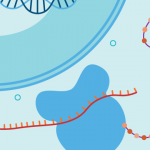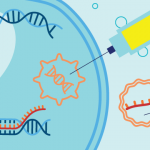
Part 6: Viral variants and immunity
As discussed in Part 1, DNA represents the recipe from which proteins are made, and each protein has its own unique genetic recipe. Every time the DNA of a virus is copied as part of it reproducing within us, there is a risk of “spelling errors” being introduced into the virus’ new DNA strand, also called a mutation. Some spelling errors do not impact a protein’s recipe, others do. A variant of concern arises when these random spelling errors end up changing something in the make-up of the virus, which makes it more infectious, dangerous or able to evade existing immunity.
Because the chance of mutation increases the more times the virus copies itself, the risk of variants emerging is related to the number of people who become infected. The more individuals who fall ill, the more times the virus can replicate, and the greater the likelihood that a new variant will develop. This is another reason why we should try and reduce the spread of COVID-19 in our communities.
If the mutation changes a DNA recipe sufficiently, the protein that is produced may look quite different from the original one that the immune system learnt to recognize in the vaccine. If this happens, the body may end up treating it like a new threat and send in the general forces, rather than the special forces that had been trained using the vaccine. The body loses the advantage of the quicker and stronger secondary immune response and the effectiveness of the vaccine drops.
Thankfully, immunity derived from vaccines may retain its protection against new variants better than does immunity following real infection, especially against severe disease. This is why it’s important to still get vaccinated even if you have previously had COVID-19.












